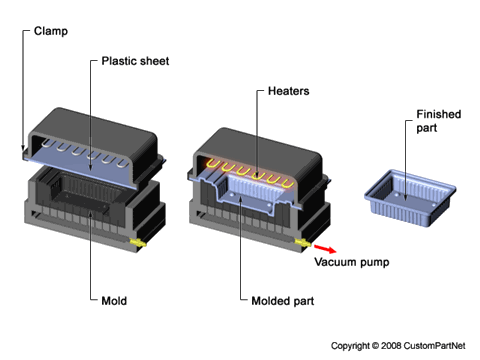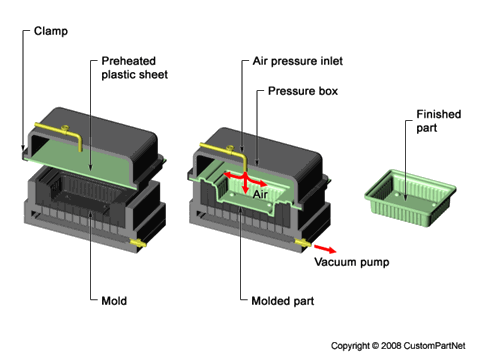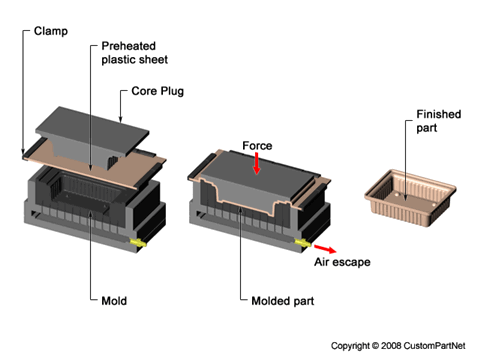(143). Start a Thermoforming Manufacturing Unit
Thermoforming is commonly used for food packaging, but has many applications from plastic toys to aircraft windscreens to cafeteria trays. Thin-gauge (less than 0.060 inches) sheets are mostly used for rigid or disposable packaging, while thick-gauge (greater than 0.120 inches) sheets are typically used for cosmetic permanent surfaces on automobiles, shower enclosures, and electronic equipment. A variety of thermoplastic materials can be used in this process, including the following:
- Acrylic (PMMA)
- Acrylonitrile Butadiene Styrene (ABS)
- Cellulose Acetate
- Low Density Polyethylene (LDPE)
- High Density Polyethylene (HDPE)
- Polypropylene (PP)
- Polystyrene (PS)
- Polyvinyl Chloride (PVC)
As mentioned above, there are different methods of forcing the thermoplastic sheet to conform to the mold. These types of thermoforming include the following:
- Vacuum forming - A vacuum is formed between the mold cavity and the thermoplastic sheet. The vacuum pressure (typically 14 psi) forces the sheet to conform to the mold and form the part shape.
- Pressure forming - In addition to utilizing a vacuum underneath the sheet, air pressure (typically 50 psi, but up to 100 psi) is applied on the back side of the sheet to help force it onto the mold. This additional force allows the forming of thicker sheets and creating finer details, textures, undercuts, and sharp corners.
- Mechanical forming - The thermoplastic sheet is mechanically forced into or around the mold by direct contact. Typically, a core plug will push the sheet into the mold cavity and force it into the desired shape.
The Thermoforming Process
The objective during the heating process is to raise the composite sheet surface and core to the correct thermoforming temperature without burning or blistering the sheet surfaces. Because plastics are good thermal insulators, the key to good thermoforming is to make sure that the cross section of the sheet is sufficiently heated to allow the entire sheet – surface and core – the ability to elongate during the forming process.
Conduction of heat from the sheet surface to the core by a slow heat soak controls the heating time required. The time required for heat to soak into the core (center) of the sheet increases with the square of the sheet thickness. The heat capacity and thermal conductivity for the materials involved will influence the rate of conduction in multi-layer, multi-material sheets.
Either one-sided or two-sided heating can be used to thermoform Solarkote® capped sheet. Two-sided heating is recommended for any heavy gauge application to maximize control and minimize time necessary to elevate the core to proper forming temperatures. Radiant heating is the best heat source.Radiant heating is the best heat source:
- Heating source of 500°F-1700°F
- Ceramic heaters radiate heat energy more efficiently than quartz or cal rod heat sources.
- ABS may absorb greater amounts of radiant energy than acrylic; thus, surface temperatures may increase more rapidly.
- Care should be taken to maintain the surface temperature at 325°F-360°F to avoid blistering, burning, color/gloss shift of the Solarkote®cap.
IMPORANT: Forming temperature is affected by:
- Sheet thickness; this is the primary limit
- Heat capacity and thermal conductivity of the plastic sheet; the type of ABS and level of regrind will affect forming temperature
- Intensity of heat source and efficiency and absorption characteristics of the sheet (minor limits)
- Forming too cold adversely affects material distribution and dramatically increases the level of residual stress from the forming cycle
For heavy-gauge (thicker than .225") sheet, Altuglas International recommends only two-sided heating to prevent long cycles, cold forming and possible overheating of the sheet surface.
Cap to Core Temperature Delta
The longer the heater percentage timers are turned on, the greater the temperature difference between the surfaces and the core (Diagram 3). This cap-to-core temperature delta can result in stress in the finished part. Stress in the finished part can compromise field performance with respect to reduced chemical resistance.
Diagram 3 indicates how the required time to heat the sheet varies with thickness. The time to heat the core of a thermoplastic sheet increases with the square of the thickness; i.e., two times the thickness will require four times the heating.
The key to minimizing stress in thermoforming is to have the interior of the sheet at the correct temperature not just the top and bottom surfaces! As the sheet thickness increases, the conduction of heat through the plastic becomes the limiting factor.
The process of heating the core can be speeded up by moving from a single-sided oven to two-sided heating (Diagrams 4 and 5), but not by increasing the amount of time the heaters are on (Diagram 3). Thermal conductivity from the sheet substrate to the sheet core controls the core heating time.
While one-sided ovens should be avoided, the following recommendations will help produce the best part from a single-sided oven:
-
- Preheat sheet for 2 to 3 hours in a hot air-circulating oven at 160°F–180°F to begin crucial heat soak.
- Dehumidified heating air is beneficial.
- Helps prevent overheating of sheet surface.
- Prevents surface defects related to volatiles being driven off rapidly (bubbling).
- Minimizes the likelihood of cold forming.
- Convection heating must be used in combination with single-sided radiant heat sources. However, the heating process should begin with the preheat cycle described above. In addition to the sheet preheating step, a 15-minute (minimum) oven heating cycle must be completed prior to forming.
- Heat transfer from air to sheet is improved by increasing the air velocity in an enclosed oven. Remember, this only raises the surface temperature. Do not overheat the surface! Allow the time required for the heat to soak into the core.
- Steps should be taken to shield oven from drafts to prevent thermal shock of the sheet during the heating and forming steps.
Thermoforming Machine

1.Produce Disposable cups ,lids, dish, containers and trays with round ,sqaure and rectangular or other shapes.
2.cam system of low noise and faster running,
3.Forming station driven by inverter
4..Servo Plug assist reduces minimizing energy use on press and saving time of adjustment .
5.Two Edge heating zones for better sheet pining ,minimizing plastic powder from film
7.Touch screen and programmable PLC control
8.Precise index accuracy utilizing Servo drive system, minimizing plastic scrap
9. Retractable, independently operated upper and lower ovens moving forwards and backwards for even temperature distributation
9.Module temperature control ensures precise temperature accuracy and easy operation
10.Accessing to all digitalized functions by pressing touch screen
11.Cam-controlled drive technology ensures 100% precise repetition of each cycle
13.Highly stressed parts are of very robust design ,with lower table and frames made of casting.
14.Little maintenance effort required and long intervals between maintenances
15.Most of Components are from multi-national suppliers assures a reliability and worldwide compatibility
| The Thermoforming Process |
The objective during the heating process is to raise the composite sheet surface and core to the correct thermoforming temperature without burning or blistering the sheet surfaces. Because plastics are good thermal insulators, the key to good thermoforming is to make sure that the cross section of the sheet is sufficiently heated to allow the entire sheet – surface and core – the ability to elongate during the forming process.
Conduction of heat from the sheet surface to the core by a slow heat soak controls the heating time required. The time required for heat to soak into the core (center) of the sheet increases with the square of the sheet thickness. The heat capacity and thermal conductivity for the materials involved will influence the rate of conduction in multi-layer, multi-material sheets.
Either one-sided or two-sided heating can be used to thermoform Solarkote® capped sheet. Two-sided heating is recommended for any heavy gauge application to maximize control and minimize time necessary to elevate the core to proper forming temperatures. Radiant heating is the best heat source.Radiant heating is the best heat source:
- Heating source of 500°F-1700°F
- Ceramic heaters radiate heat energy more efficiently than quartz or cal rod heat sources.
- ABS may absorb greater amounts of radiant energy than acrylic; thus, surface temperatures may increase more rapidly.
- Care should be taken to maintain the surface temperature at 325°F-360°F to avoid blistering, burning, color/gloss shift of the Solarkote®cap.
- Sheet thickness; this is the primary limit
- Heat capacity and thermal conductivity of the plastic sheet; the type of ABS and level of regrind will affect forming temperature
- Intensity of heat source and efficiency and absorption characteristics of the sheet (minor limits)
- Forming too cold adversely affects material distribution and dramatically increases the level of residual stress from the forming cycle
- IMPORANT: Forming temperature is affected by:
For heavy-gauge (thicker than .225") sheet, Altuglas International recommends only two-sided heating to prevent long cycles, cold forming and possible overheating of the sheet surface.
Cap to Core Temperature Delta
The longer the heater percentage timers are turned on, the greater the temperature difference between the surfaces and the core (Diagram 3). This cap-to-core temperature delta can result in stress in the finished part. Stress in the finished part can compromise field performance with respect to reduced chemical resistance.
Diagram 3 indicates how the required time to heat the sheet varies with thickness. The time to heat the core of a thermoplastic sheet increases with the square of the thickness; i.e., two times the thickness will require four times the heating.
The key to minimizing stress in thermoforming is to have the interior of the sheet at the correct temperature not just the top and bottom surfaces! As the sheet thickness increases, the conduction of heat through the plastic becomes the limiting factor.
The process of heating the core can be speeded up by moving from a single-sided oven to two-sided heating (Diagrams 4 and 5), but not by increasing the amount of time the heaters are on (Diagram 3). Thermal conductivity from the sheet substrate to the sheet core controls the core heating time.
While one-sided ovens should be avoided, the following recommendations will help produce the best part from a single-sided oven:
- Preheat sheet for 2 to 3 hours in a hot air-circulating oven at 160°F–180°F to begin crucial heat soak.
- Dehumidified heating air is beneficial.
- Helps prevent overheating of sheet surface.
- Prevents surface defects related to volatiles being driven off rapidly (bubbling).
- Minimizes the likelihood of cold forming.
- Convection heating must be used in combination with single-sided radiant heat sources. However, the heating process should begin with the preheat cycle described above. In addition to the sheet preheating step, a 15-minute (minimum) oven heating cycle must be completed prior to forming.
- Heat transfer from air to sheet is improved by increasing the air velocity in an enclosed oven. Remember, this only raises the surface temperature. Do not overheat the surface! Allow the time required for the heat to soak into the core.
- Steps should be taken to shield oven from drafts to prevent thermal shock of the sheet during the heating and forming steps.

Thermoforming Machine Manufacturers
Sai Thermoformers
Address:25, DSIDC Shed
Okhla Industrial Area Phase-1,New Delhi-110020, India
Phone:Office: , 40671799
Fax: +91-11-40501799
Mobile: , 9312505493
Email:info@saithermoformers.com
Okhla Industrial Area Phase-1,New Delhi-110020, India
Phone:Office: , 40671799
Fax: +91-11-40501799
Mobile: , 9312505493
Email:info@saithermoformers.com
Micron Maschinen & Agrotech Private Limited
Street Address: 74, Tollygunge Road
City: Kolkata State: West Bengal PIN: 700 053 Country: India
Phone:



Thanks for this posting. The information which you have provided is very good.Keep sharing such ideas in the future as well.
ReplyDeleteOften used for making sample and prototype parts that you want to explore. In more complex matters, however, large Thermoforming Machines are utilised to heat the bright coloured sheets and make them useful for mass amounts of products.
Blister Forming Machine
Skin Packaging Machine
Thermoforming Mould
Blister Forming Machine
Vacuum Forming Machine
Thermoforming Machine
Goood
ReplyDeleteHigh density polyethylene sheets
ReplyDeleteoffer excellent protection against UV radiation from the sun. This makes them suitable for outdoor applications, where exposure to sunlight is inevitable. The UV-resistant nature of HDPE sheets ensures that they do not degrade, crack, or lose their strength over time, even when exposed to prolonged sunlight.
HDPE plastic sheets are perfect for versatile uses. I used them for lining a pond, and their water resistance and durability amazed me! These high-density plastic sheets are lightweight yet robust, perfect for industrial and household projects. They’re also chemical-resistant, which makes them ideal for packaging or construction needs. These sheets are easy to handle and maintain, giving great value for money. If you're seeking a sheet of HDPE that ensures quality and performance, these are unbeatable!
ReplyDeleteNice post
ReplyDeletevacuum forming equipment for sale
Good article
ReplyDeleteMedical sterilization tray fabrication
Nice post
ReplyDeletethermoforming machine
Enhance your production capabilities with an industrial vacuum former built for large-scale plastic forming.
ReplyDelete